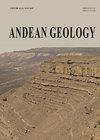Análisis de los procesos de regresión y restitución del monumento natural Puente del Inca, Andes Centrales, Provincia de Mendoza, Argentina
IF 1.2
4区 地球科学
Q3 GEOLOGY
引用次数: 0
Abstract
The Puente del Inca, next to the homonymous village, is a natural bridge located on the Cuevas River, at about 2,700 m above sea level in the Central Andes of the province of Mendoza, Argentina. Declared Provincial Natural Monument in 2005, since the beginning of the 20th century it has registered a continuous weakening, mainly related to erosive processes that cause detachments of part of the material that makes up its structure. The objective of this study is to determine the factors involved in the structural regression and restitution of the natural bridge. To achieve this, visual inspection, characterization of thermal springs, measurement of accretion-erosion rate of travertine deposits, testing of materials and the development of a structural numerical model by the Finite Element Method, were carried out. Results indicate that the deterioration is linked, mainly, with changes in the geobiological system that regulates the travertine deposition and to the heterogeneous structure of the bridge. Changes of the geobiological system are related to the activity of the thermal waters present in the area, whose discontinuity and/or fluctuations in the flow rate are influenced by both natural and anthropogenic factors. The heterogeneity of the structure conditions the stability of the monument due to the presence of a less resistant material in the lower part of the bridge arch. From the numerical simulation, safety factors between 1.5 and 3 were determined for the bridge, thus, we conclude the structure is stable against its own weight, as long as the bridge maintains the current conditions.阿根廷门多萨省安第斯山脉中部印加古桥自然遗迹的回归与恢复过程分析
毗邻同名村庄的Puente del Inca是一座天然桥梁,位于阿根廷门多萨省安第斯山脉中部海拔约2700米的Cuevas河上。2005年被宣布为省级自然古迹,自20世纪初以来,它一直在持续弱化,主要与侵蚀过程有关,导致构成其结构的部分材料脱落。本研究的目的是确定影响天然桥梁结构回归和恢复的因素。为了实现这一目标,进行了目视检查,表征温泉,测量石灰华沉积物的吸积-侵蚀速率,材料测试以及通过有限元方法开发结构数值模型。结果表明,这种恶化主要与调节石灰华沉积的地球生物系统的变化和桥梁的非均质结构有关。地质生物系统的变化与该地区存在的热水的活动有关,其流量的不连续性和/或波动受到自然和人为因素的影响。结构的非均质性决定了纪念碑的稳定性,因为在桥拱的下部有一种阻力较小的材料。从数值模拟中,确定了该桥的安全系数在1.5到3之间,因此,我们得出结论,只要桥梁保持当前状态,结构在自重下是稳定的。
本文章由计算机程序翻译,如有差异,请以英文原文为准。
求助全文
约1分钟内获得全文
求助全文
来源期刊

Andean Geology
地学-地质学
CiteScore
3.90
自引率
0.00%
发文量
17
审稿时长
>12 weeks
期刊介绍:
This journal publishes original and review articles on geology and related sciences, in Spanish or English, in three issues a year (January, May and September). Articles or notes on major topics of broad interest in Earth Sciences dealing with the geology of South and Central America and Antarctica, and particularly of the Andes, are welcomed.
The journal is interested in publishing thematic sets of papers and accepts articles dealing with systematic Paleontology only if their main focus is the chronostratigraphical, paleoecological and/or paleogeographical importance of the taxa described therein.
 求助内容:
求助内容: 应助结果提醒方式:
应助结果提醒方式:


